|
Contemporaries in the Baltic region
.
Livonian Order
Master Walter von Plettenberg, 1494-1535
Master Hermann von Brüggenei, 1535-1549 Master Johann von der Recke, 1549-1551 Master Heinrich von Galen, 1551-1557 Master Wilhelm von Fürstenberg, 1557-1559 Master Gotthard Kettler, 1559-1562 .
Bishopric of Dorpat
Bishop Jobst von der Recke, 1543-1551
|

10 ducats 1525. Ø 39 mm, 34,95 g. Haljak 242b; Neumann 222; Friedb.1; Dav.1525A as thaler. Obv.: ◦MOИEta·ИOVA· - MAGistRI·LIVOИ - Iae' Master standing with sword on his shoulder and master's coat of arms, rosette on the right in the field. Rev.: S·MARIA·Ͻ SERVA - POPVLVm◦TW◦Z5 - Mary and child surrounded by rays. Such a piece - 12 ducats, Ø 39 mm, 41.96 g.
 - is exhibited in the coin cabinet Bodemuseum, Berlin. - is exhibited in the coin cabinet Bodemuseum, Berlin.
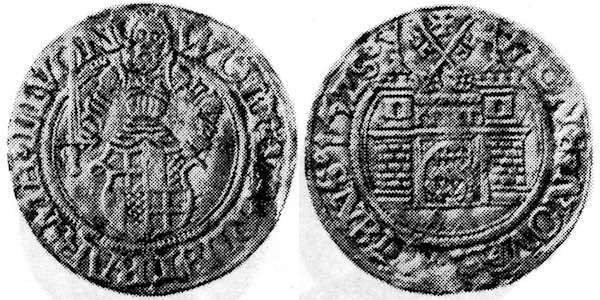
Double ducat 1528, Riga. Ø 28 mm. Neumann 226; Friedb.2. Obv.: WOLTer VAn PLETtenBERg ARgentea(?) MAgistrii LI - VOniae Rev.: MONEta NOVA RIGENSis 1528◦ - coat of arms of Riga. |
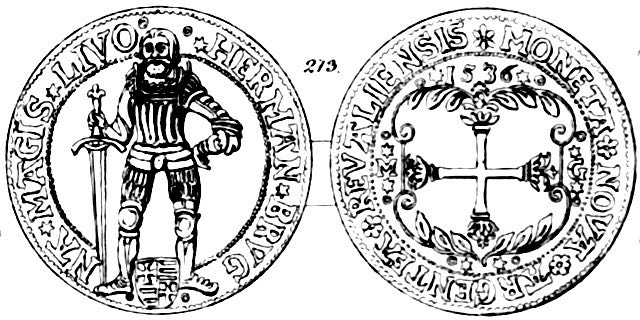
Thaler 1536, Reval. Ø 43 mm. Dav.9376; Dudik 152 (p.142); Neumann 241. Obv.: ◦*HERMANn von*BRVGge - NAi*MAGIStri*LIVOniae◦ Master of the Order standing facing, right hand supported by sword and left hand on hip. Between the feet a squared shield: cross of the Order and beam of Bruggenei. Rev.: MONETA*NOVA*ARGENTEA*REVALIENSIS* Reval's cross in a floral shield between M - G, above *1536*, below **. Dudik writes: This thaler is not embossed, but everything on it is painted yellowish on a matt green background on a pewter disc.
|
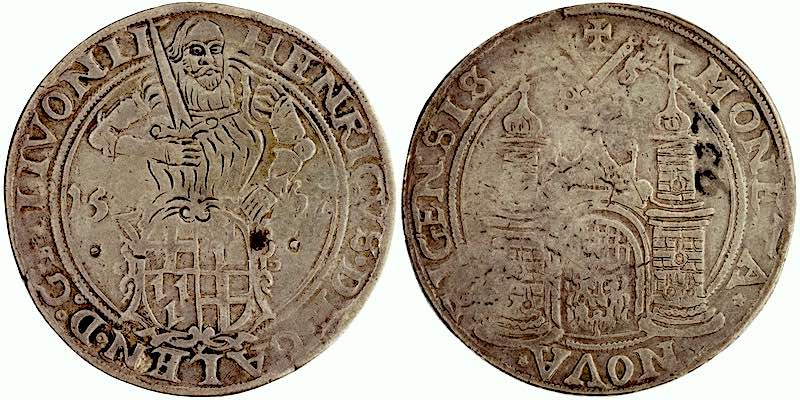
Thaler 1557, Riga. Ø mm, 27,05 g. Neumann 259; Dav.9378 (ohne Abb.) Specimen at American Numismatic Society (http://numismatics.org/collection/1960.111.86) Obv.: HENRICVS·DE·GALEN·D:G·Magistrii·LIVONII Half-length portrait behind the coat of arms and between 15 - 57. Rev.: MONETA· - NOVA· - RIGENSIS Arms of Riga: towers with gate, lion's head at the entrance, crossed keys at the top.
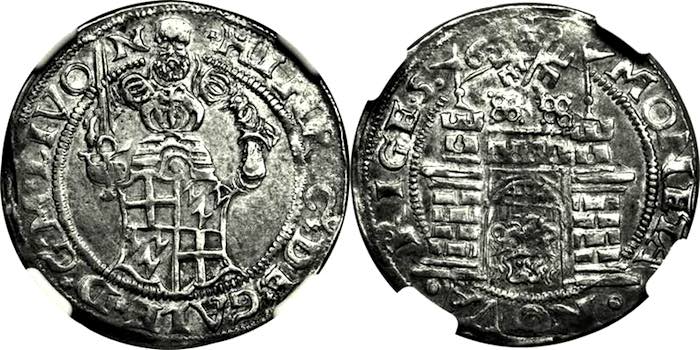
1/2 Mark 1556, Riga. Ø 28 mm, ca. 5,4 g. Neumann 261. Obv.: HINEICVS GALE D.G. M. LIVON - Master stands behind the coat of arms. Rev.: MONETA NOVA RIGENS - Arms of Riga. |
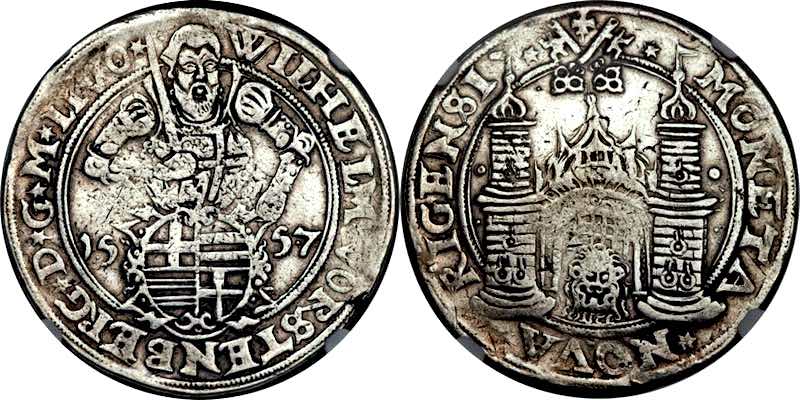
Thaler 1557, Riga. Ø 40 mm, 28,96 g. Neumann 277; Dav.9380. Obv.: WILHELM*VORSTENBERG*Dei*Gratia*Magistrii*LIVOniae* Armored hip portrait from the front, shouldering the sword with the right hand, in the foreground a shield with the coat of arms of the order and the family between the divided dates 15 - 57. Rev.: * - MONETA - *NOVA* - RIGENSI - * Arms of Riga: towers with gate, lion's head at the entrance, crossed keys at the top. |
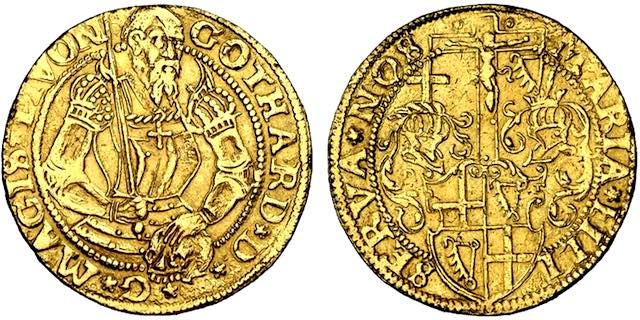
2 ducats n. d., Wenden. Ø 29 mm, 8,38 g. Neumann 285; Haljak 373; Friedb.7. Obv.: GOTHARD*Dei* - *Gratia*MAGIStri*LIVONiae - Armored hip portrait half right, shouldering sword with right hand, with left hand lying on a skull. Rev.: MARIA*FILIus - SERVA*NOS "Son of Mary, help us" Doubly helmeted, four-field shield (order cross / Kettler's coat of arms), above Christ on the cross. A similar piece - Goldgulden Ø 29 mm, 4,17 g
 - is in the Berlin coin cabinet. - is in the Berlin coin cabinet.
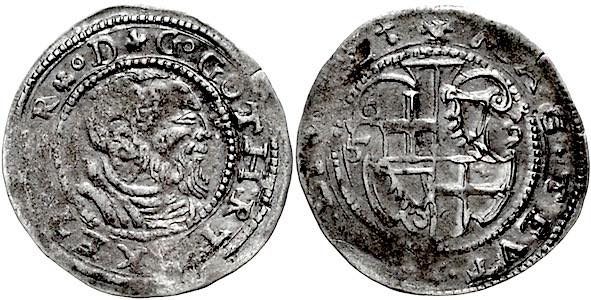
Ferding 1559, Wenden. Ø 24 mm, 2,46 g. Neumann 290a; Haljak 189. D*G.GOTH(a)RT KETTLER* Head. // *MAGister·TEVTsch·ORDen·LIVONiaE Arms. |
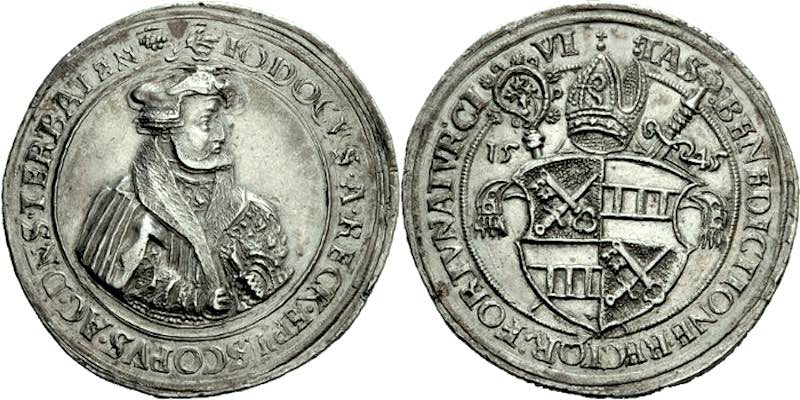
Double Thaler 1545. Ø 52 mm, 55,28 g. Dav.-; Neumann S.326; Hutten-Czapski 6568. Obv.: IODOCVS·A·RECK·EPISCOPVS·AC·DNS·TERBATEN "... Bishop and Lord of Tartu" Bearded bust with cap in surplice, looking to the right and holding a sword in his left hand. Rev.: CI - VI:TAS - .BENEDICTIONE·RECTORis:FORTVNATVR: Squared shield: bishopric (sword and key) and family arms (3 red bars on white field). Above mitre between crozier and sword, outside date 15 -45. The crosier and sword generally symbolise the spiritual and temporal power of a prince-bishop.
|
|
Lit.:
• B. Dudik: Des Hohen Deutschen Ritterordens Münz-Sammlung in Wien. Wien 1858 und im Netz. • E. Neumann: Die Münzen des Dt. Ordens in Preußen, Livland und Mergentheim, deren weltliche Nachfolger die Herzogtümer Preußen, Livland und Kurland sowie Gepräge der baltischen Geistlichkeit ca.1219-1802. Köln 1995. • Hutten-Czaski: Catalogue de la collection des médailles et monnaies polonaises du Comte Emeric Hutten-Czapski. 5 Bd., 1871-1916, Nachdr. 1957. |
 start page
start page